The Nehalem Preview: Intel Does It Again
by Anand Lal Shimpi on June 5, 2008 12:05 AM EST- Posted in
- CPUs
Faster Unaligned Cache Accesses & 3D Rendering Performance
3dsmax r9
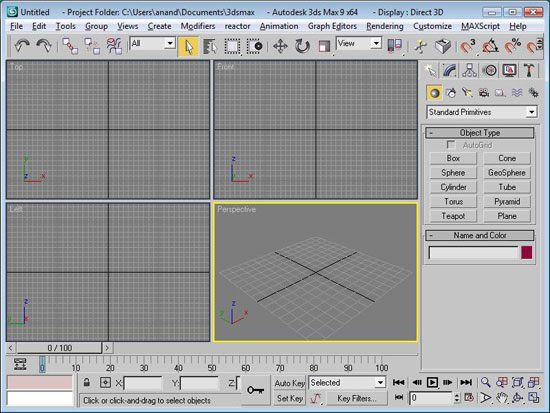
Our benchmark, as always, is the SPECapc 3dsmax 8 test but for the purpose of this article we only run the CPU rendering tests and not the GPU tests.
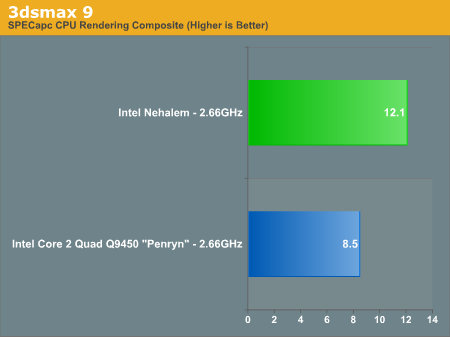
The results are reported as render times in seconds and the final CPU composite score is a weighted geometric mean of all of the test scores.
| CPU / 3dsmax Score Breakdown | Radiosity | Throne Shadowmap | CBALLS2 | SinglePipe2 | Underwater | SpaceFlyby | UnderwaterEscape |
| Nehalem (2.66GHz) | 12.891s | 11.193s | 5.729s | 20.771s | 24.112s | 30.66s | 27.357s |
| Penryn (2.66GHz) | 19.652s | 14.186s | 13.547s | 30.249s | 32.451s | 33.511s | 31.883s |
The CBALLS2 workload is where we see the biggest speedup with Nehalem, performance more than doubles. It turns out that CBALLS2 calls a function in the Microsoft C Runtime Library (msvcrt.dll) that can magnify the Core architecture's performance penalty when accessing data that is not aligned with cache line boundaries. Through some circuit tricks, Nehalem now has significantly lower latency unaligned cache accesses and thus we see a huge improvement in the CBALLS2 score here. The CBALLS2 workload is the only one within our SPECapc 3dsmax test that really stresses the unaligned cache access penalty of the current Core architecture, but there's a pretty strong performance improvement across the board in 3dsmax.
Nehalem is just over 40% faster than Penryn, clock for clock, in 3dsmax.
Cinebench R10

A benchmarking favorite, Cinebench R10 is designed to give us an indication of performance in the Cinema 4D rendering application.
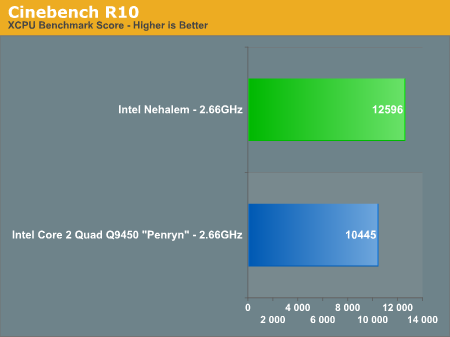
Cinebench also shows healthy gains with Nehalem, performance went up 20% clock for clock over Penryn.
We also ran the single-threaded Cinebench test to see how performance improved on an individual core basis vs. Penryn (Updated: The original single-threaded Penryn Cinebench numbers were incorrect, we've included the correct ones):
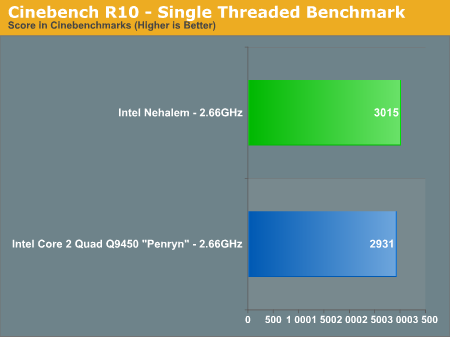
Cinebench shows us only a 2% increase in core-to-core performance from Penryn to Nehalem at the same clock speed. For applications that don't go out to main memory much and can stay confined to a single core, Nehalem behaves very much like Penryn. Remember that outside of the memory architecture and HT tweaks to the core, Nehalem's list of improvements are very specific (e.g. faster unaligned cache accesses).
The single thread to multiple thread scaling of Penryn vs. Nehalem is also interesting:
| Cinebench R10 | 1 Thread | N-Threads | Speedup |
| Nehalem (2.66GHz) | 3015 | 12596 | 4.18x |
| Core 2 Quad Q9450 - Penryn - (2.66GHz) | 2931 | 10445 | 3.56x |
The speedup confirms what you'd expect in such a well threaded FP test like Cinebench, Nehalem manages to scale better thanks to Hyper Threading. If Nehalem had the same 3.56x scaling factor that we saw with Penryn it would score a 10733, virtually inline with Penryn. It's Hyper Threading that puts Nehalem over the edge and accounts for the rest of the gain here.
While many 3D rendering and video encoding tests can take at least some advantage of more threads, what about applications that don't? One aspect of Nehalem's performance we're really not stressing much here is its IMC performance since most of these benchmarks ended up being more compute intensive. Where HT doesn't give it the edge, we can expect some pretty reasonable gains from Nehalem's IMC alone. The Nehalem we tested here is crippled in that respect thanks to a premature motherboard, but gains on the order of 20% in single or lightly threaded applications is a good expectation to have.
POV-Ray 3.7 Beta 24
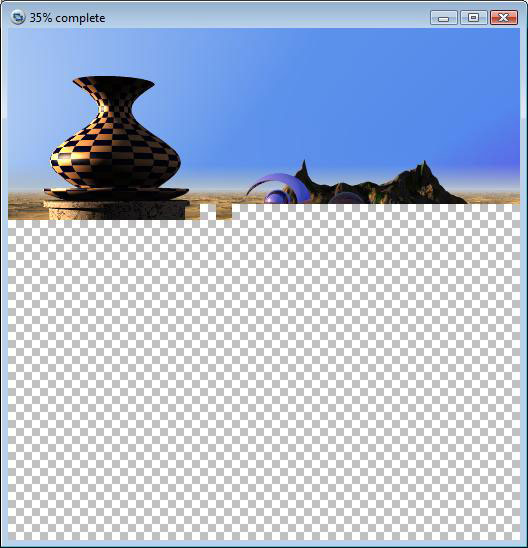
POV-Ray is a popular raytracer, also available with a built in benchmark. We used the 3.7 beta which has SMP support and ran the built in multithreaded benchmark.
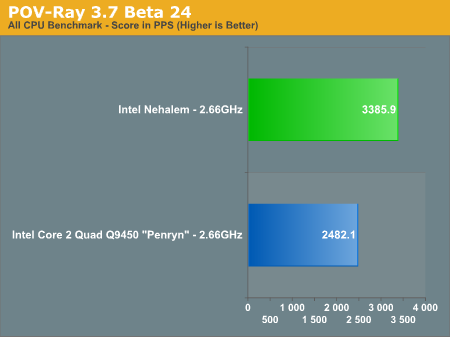
Finally POV-Ray echoes what we've seen elsewhere, with a 36% performance improvement over the 2.66GHz Core 2 Q9450. Note that Nehalem continues to be faster than even the fastest Penryns available today, despite the lower clock speed of this early sample.










108 Comments
View All Comments
Justin Case - Sunday, June 8, 2008 - link
The chances of AMD dying are approximately... zero. The question is whether they stay as an independent company or get bought by someone else. Their IP and patent portfolio alone are worth more than the company's current value, even if they didn't sell a single CPU and didn't have any fabs.The top candidate is Samsung, followed by IBM, followed by the UAE. But the real nightmare scenario is this: Microsoft buys AMD, and slowly makes its software incompatible with (or run much slower on) everyone else's CPUs. After that, they have zero incentive to improve the chips, because no one else can compete anyway.
Since it's been shown that Microsoft can violate antitrust legislation as much as it wants (as long as it pays off a few senators), this is not at all impossible. Be afraid. Be very afraid.
VooDooAddict - Monday, June 9, 2008 - link
That would be the beginning of the end for MS.MS buys AMD? .... that would be the day I buy a fully loaded Mac Pro.
Griswold - Friday, June 6, 2008 - link
Listenting to whom? Somebody as naive and clueless as you, who apparently believes breaking laws in the past should be forgiven and forgotten until there is no competition at all, because the market will magically make things work out perfectly for the customer anyway...?n0b0dykn0ws - Thursday, June 5, 2008 - link
If Nehalem comes out and does run circles around current processors, then we're better off, right?The only problem is that Intel is holding back on it's CPUs.
Without competition, Intel will only give us 'just a little taste'.
Me personally? I want the full strength version at today's prices.
n0b0dykn0ws
Rev1 - Monday, June 9, 2008 - link
AMd is still competitive in the price segment of lower end cpu's, and after the PT4 debacle intel doesnt wanna loosen it's grip anytime soon to AMD.Zurtex - Thursday, June 5, 2008 - link
You've written:"Encoding performance here went through the roof with Nehalem: a clock for clock boost of 44%."
But your graph shows the exact opposite. I'm assuming you just got the numbers on the graph the wrong way around, rather than your analysis mixed up.
Ryan Smith - Thursday, June 5, 2008 - link
Uh, sometimes bits get flipped when in transfer from Taiwan, yeah, that's it.Anyhow, thanks for the notice. Fixed.
8steve8 - Thursday, June 5, 2008 - link
exactly what I expected.imc was long overdue for intel...
can't wait to buy one, but I've been hearing us mere consumers wont be able to until well into 09?